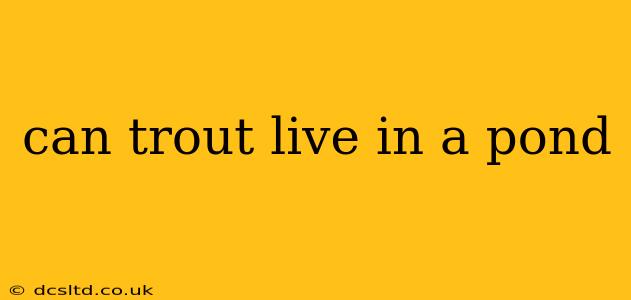Can Trout Live in a Pond? A Deep Dive into Trout Habitat
Trout, prized for their culinary excellence and sporting prowess, are often associated with pristine, flowing streams and rivers. But can these elegant fish thrive in the still waters of a pond? The answer, as with most things in nature, is nuanced and depends on several key factors. While not their ideal habitat, under specific circumstances, trout can survive and even flourish in a pond. Let's explore the conditions necessary for successful trout pond keeping.
What kind of pond is best for trout?
This is a crucial question. Simply having a body of water doesn't guarantee trout survival. The pond needs specific characteristics to support these fish. A successful trout pond needs to mimic, as closely as possible, the natural habitat of trout in their preferred streams and rivers. This means:
- Sufficient Oxygen: Trout require well-oxygenated water. Still water in a pond can quickly become oxygen-depleted, especially in warmer months. Aeration systems are often necessary to ensure sufficient oxygen levels for trout survival.
- Appropriate Temperature: Trout are cold-water fish, preferring temperatures between 40°F and 70°F (4°C and 21°C). Warmer temperatures stress trout and can lead to disease and death. Pond location and depth will play a crucial role in maintaining suitable temperatures. Shading the pond from direct sunlight can help.
- Clean Water: Trout are sensitive to water quality. High levels of pollutants or excessive algae can be detrimental to their health. Regular water testing and filtration might be necessary to maintain a healthy aquatic environment.
- Adequate Size and Depth: A pond needs to be large enough to accommodate the number of trout you intend to keep, providing ample swimming space. Sufficient depth provides cooler water layers in warmer months.
- Suitable Substrate: The pond bottom should offer suitable hiding places and protection for the trout, similar to the rocky bottoms of their natural habitats.
What are the challenges of keeping trout in a pond?
While it's possible, keeping trout in a pond presents several challenges compared to maintaining them in a flowing stream environment. These challenges include:
- Oxygen Depletion: As mentioned above, this is a major concern in still water.
- Temperature Fluctuations: Ponds are more susceptible to temperature swings than rivers, posing a significant threat to trout's survival.
- Disease Outbreaks: In a confined space like a pond, diseases can spread quickly among trout. Careful monitoring and preventative measures are vital.
- Predators: Depending on the pond's ecosystem, various predators (birds, larger fish, etc.) might prey on the trout.
What type of trout is best suited for a pond?
Not all trout species are equally suited for pond life. Some species are more tolerant of warmer temperatures and lower oxygen levels than others. However, even the most adaptable species will require careful management to thrive in a pond environment. Researching the specific needs of the trout species you choose is essential.
Can I stock trout in a naturally occurring pond?
Stocking a naturally occurring pond with trout often carries greater challenges. You need to carefully assess the existing ecosystem, water quality, and potential predators before introducing trout. It's advisable to consult with local fisheries or wildlife management agencies to determine the feasibility and legality of stocking trout in a natural pond in your area. Unsuitable conditions could lead to the trout's demise and disrupt the existing pond ecosystem.
How can I ensure the success of my trout pond?
Success hinges on meticulous planning and ongoing management. This includes:
- Regular Water Testing: Monitor water parameters (temperature, oxygen levels, pH, etc.) frequently.
- Aeration System: Invest in a reliable aeration system to maintain sufficient oxygen levels.
- Filtration System: Employ a filtration system to remove waste and maintain water clarity.
- Predator Control: Take measures to protect trout from predators.
- Appropriate Stocking Density: Avoid overcrowding the pond.
In conclusion, while not their natural preference, trout can live in a pond, but it requires careful planning, diligent monitoring, and a considerable investment in maintaining a suitable environment. Success depends entirely on closely replicating the conditions they would find in their native fast-flowing rivers and streams. It's a challenging endeavor that demands commitment and expertise.
